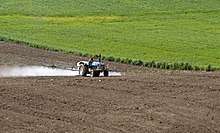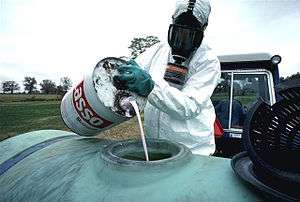Pesticide drift
Pesticide drift refers to the unintentional diffusion of pesticides and the potential negative effects of pesticide application, including off-target contamination due to spray drift as well as runoff from plants or soil. This can lead to damage in human health, environmental contamination, and property damage.[1]

Types
With placement (localised) spraying of broad spectrum pesticides, wind drift must be minimized, and considerable efforts have been made to quantify and control spray drift from hydraulic nozzles.[2] Conversely, wind drift is also an efficient mechanism for moving droplets of an appropriate size range to their targets over a wide area with ultra-low volume (ULV) spraying.[3]
Himel (1974) made a distinction between exo-drift (the transfer of spray out of the target area) and endo-drift, where the active ingredient (AI) in droplets falls into the target area, but does not reach the biological target. Endo-drift is volumetrically more significant and may therefore cause greater ecological contamination (e.g. where chemical pesticides pollute ground water).[4]
Bystander exposure describes the event when individuals unintentionally come in contact with airborne pesticides. Bystanders include workers working at an area separate to the pesticide application are, individuals living in the surrounding areas of an application area, or individuals passing by fields as they are being treated with a pesticide.[5]

Herbicide volatilisation
Herbicide volatilisation refers to evaporation or sublimation of a volatile herbicide. The effect of a gaseous chemical is lost at its intended place of application and may move downwind and affect other plants not intended to be affected causing crop damage. Herbicides vary in their susceptibility to volatilisation. Prompt incorporation of the herbicide into the soil may reduce or prevent volatilisation. Wind, temperature, and humidity also affect the rate of volatilisation, with humidity reducing it. 2,4-D and dicamba are commonly used chemicals that are known to be subject to volatilisation,[6] but there are many others.[7] Application of herbicides later in the season to protect herbicide-resistant genetically modified plants increases the risk of volatilisation as the temperature is higher and incorporation into the soil impractical.[6]
Public concern
Although there has been much public concern and research into spray drift, point source pollution (e.g. pesticides entering bodies of water following spillage of concentrate or rinsate) can also cause great environmental harm. [8] Public concern for pesticide drift is not met with adequate regulatory response. Environmental justice advocates in California, for instance, consider moving up the scale of the discourse on pesticide drift by categorizing it as air pollution in order to receive attention from state environmental protection.[4]
Farm workers and communities surrounding large farms are at a high risk of coming in contact with pesticides. The San Joaquin valley in California has seen numerous cases of illnesses resulting from exposure to pesticides through pesticide drift. Organizations such as United Farm Workers Union have fought to implement legislation that would reduce and hold farmers accountable for pesticide drift. The California Department of Pesticide Regulation estimates that between 37-68% of pesticide illness among U.S. agricultural workers come as a result of pesticide drift. [9]
Insecticides sprayed on crop fields can also have detrimental effects on non-human life forms that are important to the surrounding ecosystems like bees and other insects. [10]
From 1998 to 2006, Environmental Health Perspectives found nearly 3,000 cases of pesticide drift, nearly half were workers on the fields treated with pesticides and 14% of cases were children under the age of 15. [11]
See also
References
- "Community Guide to Recognizing and Reporting Pesticide Problems". CA Dept. of Pesticide Regulation. Retrieved 25 March 2011.
- Hewitt, A.J., Spray drift: impact of requirements to protect the environment, Crop Protection 19 (2000) p 623-627
- Harrison, Jill Lindsey (29 July 2011). Pesticide Drift and the Pursuit of Environmental Justice. The MIT Press. doi:10.7551/mitpress/9780262015981.001.0001. ISBN 9780262015981.
- Harrison, Jill Lindsey (2006). "'Accidents' and Invisibilities: Scaled discourse and the naturalization of regulatory neglect in California's pesticide drift conflict". Political Geography. 25 (5): 506–529. doi:10.1016/j.polgeo.2006.02.003.
- Matthews, Graham (2016). Pesticides : Health, Safety and the Environment. Hoboken, NJ: Chichester, West Sussex; Wiley Blackwell.
- Andrew Pollack (25 April 2012). "Dow Corn, Resistant to a Weed Killer, Runs Into Opposition". The New York Times. Retrieved 25 April 2012.
- Fabian Menalled and William E. Dyer. "Getting the Most from Soil-Applied Herbicides". Montana State University. Archived from the original on 21 December 2012. Retrieved 25 April 2012.
- Spanoghe, Pieter; Maes, An; Steurbaut, Walter (2004). "Limitation of point source pesticide pollution: Results of bioremediation system". Communications in Agricultural and Applied Biological Sciences. 69 (4): 719–32. PMID 15756863.
- https://ebookcentral.proquest.com/lib/howard/reader.action?docID=4336000%5B%5D
- McEwen, F.L. (1977), "Pesticide Residues and Agricultural Workers—An Overview", Pesticide Management and Insecticide Resistance, Elsevier, pp. 37–49, doi:10.1016/b978-0-12-738650-8.50008-4, ISBN 9780127386508
- Lee, Soo-Jeong; Mehler, Louise; Beckman, John; Diebolt-Brown, Brienne; Prado, Joanne; Lackovic, Michelle; Waltz, Justin; Mulay, Prakash; Schwartz, Abby (August 2011). "Acute Pesticide Illnesses Associated with Off-Target Pesticide Drift from Agricultural Applications: 11 States, 1998–2006". Environmental Health Perspectives. 119 (8): 1162–1169. doi:10.1289/ehp.1002843. ISSN 0091-6765. PMC 3237344. PMID 21642048.
- US EPA, OCSPP (4 September 2014). "PRN 2001-X Draft: Spray and Dust Drift Label Statements for Pesticide Products". US EPA. Retrieved 11 December 2018.
Sources
- "Pesticide Spray and Dust Drift". Pesticides: Topical & Chemical Fact Sheets. Environmental Protection Agency. Retrieved 25 March 2011.
Notes
- Himel, C.M. (1974) Analytical methodology in ULV. In: Pesticide application by ULV methods British Crop Protection Council Monograph No. 11, 112-119.
- Matthews G.A. (2006) Pesticides: Health, Safety and the Environment Blackwell, Oxford
External links
- EarthJustice - health impacts of pesticide drift in rural farming community
- Pesticide Action Network North America (PANNA)- "Advancing alternatives to pesticides worldwide"
- International Pesticide Application Research Centre (IPARC)
